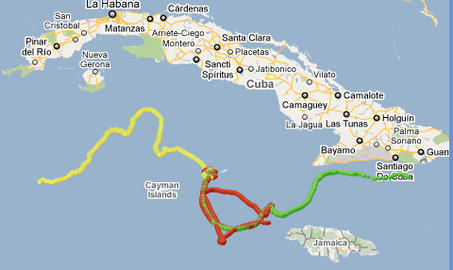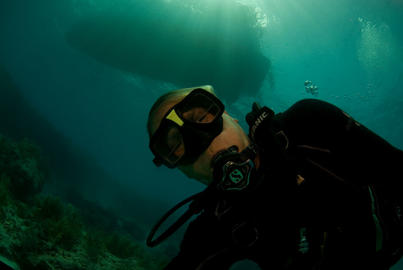$2,417 per person double occupancy. Package Includes – 7 nights accommodations in an over-the-water bungalow, five days of 2-tanks dives, all meals at the picturesque Coral Lodge, and round trip transfers* from Panama City (airport code - PTY). *transfer times -- departing no later than 1:30pm from Panama City on June 16, departing no earlier than 7am from Coral Lodge on June 23. The transfer takes 2.5 hours between Panama City and Miramar and 30 minutes from Miramar and the Lodge.
As part of the Grouper Moon Project, REEF launched the Baby Grouper Adrift! webpage in late February. We developed this outreach tool to display in real time the results of state-of-the-art satellite drifter research being conducted by researchers from REEF, the Cayman Island Department of Environment, and Oregon State University. The Adrift project aims to better understand where Nassau grouper larvae end up after being spawned.
REEF recently awarded Nancy Perez the 2010 Key Largo Community Volunteer Award. Nancy joined during REEF's inaugural year in 1993! She lives in the Florida Keys and has become an instrumental volunteer at REEF Headquarters in Key Largo. Nancy helps connect REEF with the local community through planning special events, including holiday parties, the James E. Lockwood REEF Headquarters dedication, and participation at local festivals. Nancy has also encouraged other locals to volunteer at REEF HQ and is always available to assist REEF staff on projects.
Every month, scientists, government agencies, and other groups request raw data from REEF’s Fish Survey Project database. Here is a sampling of who has asked for REEF data recently and what they are using it for:
- An educator and researcher from the University of Connecticut is using data as part of a field science class. His students will use the data to evaluate fish populations in advance of their field coursework.
REEF members are at the heart of our grassroots marine conservation programs. Over 43,000 divers, snorkelers, students, and armchair naturalists stand behind our mission.
This month we highlight Franklin Neal (REEF member since 2000). Franklin and his wife Cassandra (also an active REEF member) spend much of their time in Bonaire these days, but they originally called New York home. Franklin has conducted 1,179 REEF surveys! and he is a member of the Advanced Assessment Team in the Tropical Western Atlantic. Here's what Franklin had to say about REEF:
REEF is proud to partner with over 130 dive shops, dive clubs, individuals, and other organizations as REEF Field Stations.
Hunt lionfish for cash prizes! Please note that ALL TEAM MEMBERS MUST HAVE THEIR LIABILITY WAIVERS TURNED IN BEFORE OR AT THE CAPTAIN'S MEETING ON MAY 13th.
During the Captain's Meeting, we will cover the basics of lionfish biology and the invasion, safe handling practices, and rules for the derby. It is important to note that ALL TEAM MEMBERS MUST TURN IN LIABILITY WAIVERS BEFORE OR AT THE CAPTAIN'S MEETING.
The Florida Department of Environmental Protection Coral Reef Conservation Program is hosting marine life identification courses throughout the month of April. On April 5 and 6, the topic is Fish Identification and will be taught using REEF Fish ID materials. Participate and learn your reef fish!



